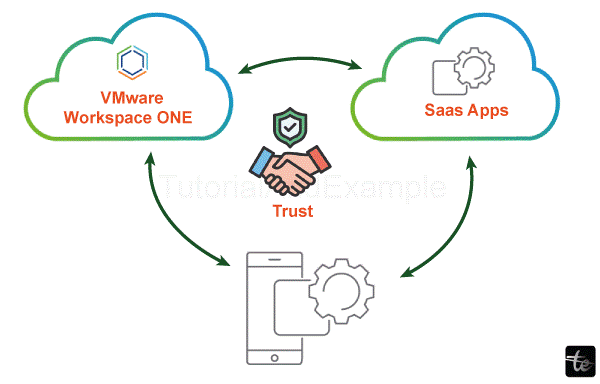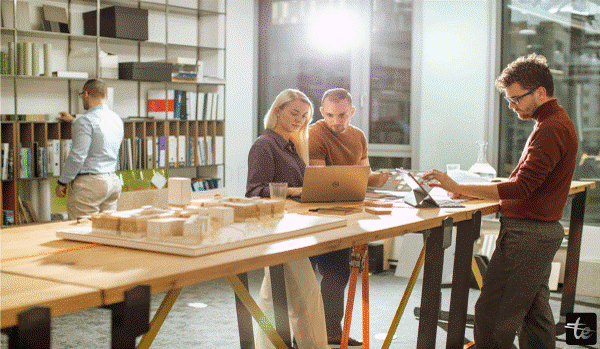What is Workspace?
Your workstation is where you perform your work. It might be a physical workplace, such as a desk, office, or room. It may also refer to a digital workspace where you arrange files, papers, and tools to complete your job on a computer or online. Essentially, it's any space or setting where you concentrate and work on tasks associated with your profession or interests.

The space used for work-related tasks is called a workspace. It's more than a bodily space; it has everything required to do tasks effectively. This is probably a co-running area, an ordinary workplace, a far-off work association from home, or even a hybrid version combining several kinds of paintings.
It's important to realize that a laptop accommodates the physical space, equipment, lifestyle, and generation that facilitate work-associated tasks. The concept of a computer has modified dramatically at some point in time. Initially, offices in ancient times varied, from farms to artisan workshops, reflecting the dominant monetary and social hobbies. The Industrial Revolution brought about a profound change. The emergence of factories and organized painting environments modified how people worked. The introduction of present-day office layouts, which moved far away from locked cubicles and closer to open-plan workspaces, furthered this shift and further ingrained generation into our operating life.
Workspaces in recent times aren't limited to traditional offices; with the improvement of technology, faraway work—which lets humans do business from home or every other location with net admission—has grown in reputation. Co-operating spaces—shared workspaces wherein personnel from several corporations collaborate—have also grown in popularity. The hybrid work paradigm gives flexibility without entirely casting off a physical computing device by combining conventional and far-off painting factors.
Historical View of Workplaces

Recognizing how workplaces have modified throughout time is critical to comprehending the historical attitude on workspaces.
1. Old Workspaces
Back then, the offices had been intently associated with the social and financial systems that were in location. These areas differed greatly based totally on the type of work they achieved. In agricultural communities, for example, fields had been the primary places of employment where humans tilled the soil, planted seeds, and collected harvests. Workspaces in artisanal communities had been regular workshops or studios where artisans worked at their abilities and produced several hofahandmadeadgets.
These archaic labour places were often decentralized and intimately related to the herbal world. For example, artisan workshops were usually placed in small towns where artisans lived and worked, while agricultural offices were centred across the seasons and herbal cycles.
2. The Industrial Revolution and the Transformation of Workspaces
The records of the place of work underwent a dramatic shift with the Industrial Revolution. The creation of equipment and the economic revolution circulated toward vital offices. As a result of gathering many humans under one roof to run equipment and make items in large quantities, factories developed as manufacturing centres.
Work settings emerge as extra dependent and organized due to this change. Assembly strains, in which employees repeatedly completed specialized jobs, had been a defining function of factories. The PC has become standardized, with awesome sections set aside for various production methods. It changed into specific from the dispersed and often more flexible work environments of the past.
3. Making the Switch to Modern Workspaces
Office tradition and corporate environment brought extra workstation changes after the Industrial Revolution. Office buildings, departmental divisions, and booths have become the same old. The workplace changed at some point to accommodate paperwork, administrative duties, and organizational hierarchies.
Innovations in technology were vital to this transformation. Work changed and finished in a specific way as soon as computer systems, telephones, and the internet were incorporated. The current place of business layout we are acquainted with today became possible using this progression.
Types of Workspaces

1. Traditional Office Setups
Most people are familiar with everyday work areas and traditional workplace layouts. These areas commonly encompass an office building or notebook wherein workers and contributors assemble to perform their duties.
Conventional office areas include personal offices, convention rooms, booths, and commonplace areas like damaged rooms. Workers frequently have distinct workstations or desks, which leads to an organized and centralized workspace.
Face-to-face contact is the primary way of communique and cooperation, permitting crew contributors to speak right now and constructing an experience of camaraderie. Employees at an average workspace are predicted to be present during distinct durations and adhere to defined working hours.
Traditional workplace layouts offer improved cooperation, greater supervision, and a more formal setting that promotes choice-making and open communication. They could also be linked to the pressure of commuting, inflexible scheduling, and constrained flexibility.
2. Workspaces which can be Remote
Employees can work from areas other than a central workplace thanks to faraway workspaces, which offer damage from the usual workplace setting. Due to the improvement of the internet and generation in recent years, this configuration has become increasingly common.
Remote people can pick out to work from any place with internet connectivity, which includes their houses or coworking areas. Digital tools and conversation structures are often employed in far-flung places of work to enable collaboration and connectivity among group individuals who are dispersed throughout diverse geographic areas.
More scheduling flexibility is provided by using this type of workspace, allowing human beings to manipulate their time more effectively. Additionally, operating remotely cuts down on trip time, which may additionally lower stress and improve paintings-lifestyles stability.
However, there are drawbacks to operating remotely, including the possibility of loneliness, communication problems, and the requirement for willpower and power to keep output levels high. It can also make it more difficult to differentiate between work and private lifestyles, which might bring burnout if not properly handled.
Qualities of a Productive Work Environment
Certain essential capabilities in a green workspace foster an atmosphere that benefits efficiency and well-being.
Comfort and Ergonomics
A workspace's ergonomics consists of its layout, which minimizes bodily stress on users and increases comfort. This includes devices to promote excellent posture, appropriate lights to lessen eye strain, and ergonomic furniture, including desks and seats that can be adjusted to a man's or woman's options. In addition to lowering aches and other health problems, comfortable environments help people concentrate more on their paintings without interruptions.
Integration of Technology
Technology is effortlessly incorporated into efficient workstations to enhance productiveness and teamwork. This entails having a modern software program, dependable net access, and gear for mission control and conversation. An effective painting surroundings is fostered by accessing technology that allows group member interactions and supports the activities at hand. Moreover, automating monotonous operations with hardware and software programs may free up time for greater strategic and creative projects.
Cooperation and Interaction
A productive workstation encourages cooperation and candid conversation amongst its users. This entails putting in actual and digital locations where human beings can collaborate without problems, change ideas, and communicate about initiatives. Team members may collaborate without a doubt via file sharing, video conferencing, and immediate messaging once they use green structures and tools for communication. Innovative problem-fixing, cooperation, and a cohesive work environment are all facilitated by selling an environment of open communication and teamwork.
Workspace Effect on Productivity
1. Productivity and Workspace Design
The layout of their computer pretty much influences a character's productivity. A well-designed computer considers general comfort, lighting, association, and ergonomics. Ergonomics is vital in layout because it guarantees that furniture, including desks and chairs, is made to sell good posture and reduce bodily strain and pain. Sufficient lightin, naturally going on mild or artificial mild that may be adjusted, can enhance temper and application, increasing productivity.
Furthermore, the workspace's arrangement is important. An open-format encourages crew participants to paint collectively and communicate, which allows alternative and trouble-solving. Conversely, if an undertaking requires interest and little outdoor interruption, supplying quiet or remote places can help with attention. A healthy blend of personal and collaborative rooms allows workers to pick the settings that fit their needs, increasing output.
2. Productivity and the Integration of Technology
One of the most essential methods to increase productivity in a workspace is to use cutting-edge technology. Collaboration and workflow are simpler by accessing suitable generation and software, high-velocity internet, and effective communication gear.
Teams may collaborate no matter the location to answer questions through video conferencing, challenge control software, and shared report repositories. This integration reduces obstacles to the conversation, hurries up decision-making, and guarantees tasks are completed on time, all of which contribute to growth in general productivity.
Furthermore, ergonomic add-ons, specialized software tools, and workstations equipped with the most modern generation can help raise productivity and performance considerably. These technological tendencies benefit productiveness by streamlining techniques and creating cosy and efficient work surroundings.
Creating the Perfect Workplace

1) Customized Spaces Are Important for Workspace Design
Personalized running settings are vital for maximizing well-being, consolation, and productivity. Customizing the surroundings to meet someone's requirements, possibilities, and operating habits is called personalization. This approach recognizes that every employee is different and may perform better in a distinct environment.
Workspace customization may involve little tweaks or larger improvements. It might involve giving employees the freedom to pick how to sit, giving them chairs and desks that may be adjusted, or permitting them to decorate or add flowers or different items that speak to them to their instantaneous environment.
Giving people the possibility to personalize their workplace encourages a sense of pride and network. Increased motivation, painting pride, and a greater feeling of identity inside the business enterprise may result from this sense of possession. Additionally, customized environments can improve mental fitness, consolation, and creativity to improve output and overall work performance.
2) Finding an Equilibrium Between Public and Confidential Areas
In place of job layout, striking the precise mix among open collaboration areas and personal rooms is crucial. Employee collaboration, engagement, and verbal exchange are all facilitated through open environments. These spaces are perfect for group meetings, brainstorming periods, and constructing camaraderie among coworkers.
Having private areas set off is just as critical. These areas supply teams of workers participants with the privateness they want to pay attention to on jobs that call for private conversations, personal calls, or focused interest. These private regions are probably separate workstations with soundproofing, enclosed convention rooms, or silent areas.
Understanding the various demands of employees and the types of jobs they hold lets you discover the best balance among these non-public and open locations. It entails setting up a place that values calm, concentrated paintings as much as cooperation.
Innovations in Workspace Design
How we paint has changed dramatically because of the ingenious designs that have revolutionized workspaces. These tendencies focus on growing work settings that improve output, encourage innovation, and prioritize people's well-being.
1. Intelligent Office Technology
The incorporation of clever workplace technology is one of the noteworthy advancements. These technologies make the workspace more efficient using sensors and a networked system. For example, clever lights promote an economical electricity system and offer ideal operating lighting fixture conditions by adjusting according to the provision of natural light and the presence of employees.
IoT (Internet of Things) gadgets also reveal how much space is used, facilitating corporations' recognition of their workplace utilization. Efficient area allocation and layout improvements based on actual-time utilization styles are viable using this statistics-pushed technique. Workers gain from a more customized and bendy work environment appropriate to their preferences and desires.
2. Adaptable and Flexible Layouts
One other noteworthy innovation concerns layouts, which can be adjustable and adaptable. Fixed workspace arrangements are not the norm. Rather, they price adaptability, making arranging areas to fit various demands and work styles simple.
Modular furnishings, adjustable partitions, and adaptable layout ideas make transitions between non-public offices and shared regions easier. This flexibility encourages agility within the place of work, facilitating more than a few jobs and inspiring unplanned encounters amongst workforce contributors.
The intention of these trends in place of job design is to create settings that accommodate paintings whilst additionally evolving to satisfy the needs of the modern-day worker. They positioned comfort, productiveness, and teamwork first for personnel, which improves the operating surroundings as a whole.
Aspects of Workspace Psychology
Beyond the simplest bodily association, workplaces impact our intellectual fitness, motivation, and productivity.
- Effects on Emotional Well-Being: The ecosystem in which we paint greatly affects our intellectual health. Recognizing and raising pressure tiers may be harder when one's workspace is disorganized or disorderly. Conversely, a tidy and appealing laptop may encourage serenity and awareness.
A workspace's popular surroundings, hues, and lights all rely on. Natural mild, calming colourings and natural additives like plant life can enhance temper and lessen weariness or anxiety.
- Impacts on Productivity and Motivation: Productivity and motivation are also motivated by the association of the workplace. Creativity and teamwork can be greater in an environment that values social contact and cooperation. However, an excessively noisy or distracting setting may make it hard to be aware and efficient. Furthermore, having rooms or settings that can be uniquely yours and sell seclusion and attention can boost motivation. Performance and task pleasure may result from personnel feeling at peace with their environment.
In preferred, the psychological element of workspaces highlights how vital it is to design spaces that support mental fitness, motivation, and productivity so people can flourish at paintings.
Challenges in Modern Workspaces
Modern offices go through troubles that affect employees' performance, productivity, and well-being inside the fast-paced administrative centre.
1. Transition to Remote Work
Even at the same time, as far-flung employment offers freedom, there are drawbacks to this circulation. Collaboration may be hampered with the aid of conversation boundaries brought on by a lack of in-character connection. When business and between-life boundaries develop hazy in home settings, juggling the two becomes more difficult, and mental and emotional well-being may be impacted by feelings of isolation and detachment.
2. Integration of Technology
The brief development of the generation offers each opportunity and difficulty. Although current software programs and technologies simplify procedures, they regularly crush workforce members. Workflow may be hampered, and tech-associated strain can also arise from common upgrades and studying curves.
Furthermore, preserving cybersecurity in far-flung painting environments is difficult and necessitates strong safety features to shield crucial statistics and structures.
3. Unequal Workspace
Appropriate places of work are not to be had for everyone. There are differences between those with the appropriate home office and those who do not have enough money or a living area. An inadequate workplace, erratic nets, and uncomfortable furnishings will disproportionately impact employees' proper being and productivity, levelling the gambling area.